Abstract
In the described studies, raw material from chemically recycled petrochemical foam and biobased polyurethane foams (100% of rapeseed oil polyol were used in polyol premix) were utilised in order to obtain viscoelastic foams. The recycled foams exhibited differences in chemical structure, resulting in the formation of four different repolyols. The obtained repolyols were employed as replacements for 10 to 30 wt.% of the petrochemical polyol in the mixture utilised to produce viscoelastic polyurethane foams. It was determined that the chemical structure of the polyol utilised for the foam’s initial production influences the properties of the repolyols obtained and thus also the properties of the viscoelastic foams obtained using them. It was found that foams obtained with the addition of 10 wt.% repolyols were characterized by the best properties among the obtained modified foams, comparable or even better than in the case of petrochemical reference foam. The apparent density of such foams was about 70 kg/m3. Depending on the type of repolyol used, the hardness of the foams ranged from 2 to 8 kPa, and the comfort factor was between 2.5 and 5.0. The foams obtained were characterised by their ability to absorb energy, as evidenced by a resilience of no more than 10% in most cases. However, increasing the percentage of repolyol in the reaction mixture caused too many changes in the structure of the polymer chains, disrupting the arrangement of rigid and elastic segments, which caused the hardness to increase significantly, and the foams were therefore more susceptible to permanent deformation.
1. Introduction
Polyurethanes are among the most significant polymeric materials due to their versatility in production and applications. They are primarily manufactured in rigid foams, which are utilized in the construction industry as insulation, and flexible foams, which are commonly utilized in the furniture industry []. Other forms of polyurethanes include elastomers, coatings, and adhesives. The production of polyurethanes continues to expand, reaching 26 million tonnes globally in 2022 [,]. As polyurethane production increases, the quantity of waste generated also rises. Waste polyurethane foams are particularly challenging to manage due to their high volume and low apparent density. In light of the imperative to protect the environment and adhere to legal regulations, manufacturers are compelled to implement the principles of a 3R economy and sustainable development. These principles emphasise the importance of recycling and the pursuit of new sources of raw materials for polymers []. In response to these challenges and the threat of polymer waste, environmentally friendly raw materials for polymer production are being introduced. Concurrently, significant progress has been made in the development of recycling technologies to convert polymer waste into valuable raw materials. Consequently, only 29.7% of polyurethane waste is currently recycled, with 39.5% being used for energy recovery, while the remaining 30.8% is disposed of in landfills []. A number of European Union countries have implemented landfill ban directives, including the Netherlands, Denmark, Sweden, Switzerland, Austria, and Germany []. In addition to this, Germany has adopted a policy of achieving zero waste to landfill by 2025, which has led to an increased focus on the potential for developing new materials using polymer waste, which is regarded as a valuable and versatile resource [].
Two principal approaches to the recycling of polyurethane materials have been identified, namely mechanical and chemical []. Mechanical recycling involves the transformation of polyurethane into flakes or powder, which can then be used to produce new materials. This process is facilitated by a range of technologies, including meshing, re-bonding, compression moulding or injection moulding []. Shredded polyurethanes are usually pressed and glue-bonded into finished parts. It is used as sound-absorbing materials [], insulation panels [], sports mats [] or as filler in premixes for polyurethane foams [] and concrete fillings []. The mechanical recycling of rigid foams leads to an inherent deterioration of their properties when they are milled, for example by shredding. This means that foams can only be recycled in this way a limited number of times. Therefore, it is not a suitable long-term alternative to the current plastics life cycle [].
Another way (called mechano-chemical) to improve the sustainability of polyurethane foams and turn their waste into a valuable product is to reprocess them using vitrimers, which are polymeric materials with reversible covalent bond networks. The dynamic bonds in vitrimers can undergo topological rearrangement reactions stimulated by temperature, pH or light, enabling the reprocessing of thermosetting resins [,]. In this method, the waste of polyurethane foam containing embedded vitrimers is milled and then pressed at elevated temperatures to produce solid materials such as elastomers [,] or foams [] without the use of additional substances.
Despite the possibility of reusing polyurethane scrap, the market applications of mechanical recycling are limited to the production of agglomerates. In contrast, chemical recycling involves the depolymerisation of polyurethane waste into oligomers and smaller molecules, such as polyols. These can be used to produce new polyurethane products. Despite the equipment, energy and reagents required for this process, chemical recycling provides raw materials that can be suitable to produce new materials, which can make it economically advantageous. Several methods are currently available for the chemical recycling of polyurethane: hydrolysis, aminolysis, acidolysis and glycolysis, which are carried out using water, amines, acids or glycols, respectively. All of these methods typically require elevated temperatures of 50–220 °C for 2–10 h to achieve the chemical decomposition of polyurethane []. After the reaction has taken place, the recovered polyol (repolyol) is usually subjected to a separation and purification process []. Currently, chemical recycling is not carried out on a large scale, and more cost-effective methods are still being developed. Consequently, much polyurethane waste is incinerated to recover energy [].
It is notable that the chemical recycling of polyurethane waste remains relatively undeveloped, despite the significant potential for economic benefits. It is recommended that producers of polyurethane materials be presented with a comprehensive range of options for the utilisation of repolyols, which they may then implement in their respective businesses. Furthermore, this is in accordance with the objectives set out in the 2030 Agenda for Sustainable Development, which was adopted by all UN member states in 2015 []. Particular emphasis is placed on sustainable production and consumption. Recycling of polyurethane materials can help encouraging companies to consider closed-loop economy models as viable alternatives. Ultimately, the use of recycled raw materials increases the eco-efficiency of the resulting polyurethane materials.
Traditional polyurethane materials are mainly based on fossil raw materials that are derived from crude oil []. However, the use of renewable and recycled raw materials is becoming increasingly popular due to growing environmental concerns. In the literature, there is an increasing number of descriptions each year of polyurethane materials made from various types of renewable raw materials such as biopolyols. In some cases, materials are described that are obtained using only biopolyols instead of petrochemical polyols [,,,]. This situation leads us to believe that in the coming years, the number of industrially produced polyurethane materials on a large scale will include renewable polyols. It should be noted, though, that even polyurethanes made from renewable resources will soon be landfill waste and will need to be recycled. This means that renewable raw materials such as rapeseed or sunflower oil, which were used to produce polyurethane material, will be used again in the shape of their derivatives as a secondary raw material for polyurethane production, extending their life cycle. If attempts to recycle biopolyurethanes are successful and if the resulting rebiopolyols have similar or even better properties than traditional petrochemical repolyols, then a wide range of products can be manufactured using them. This would be a significant advancement in the development of eco-friendly polyurethane materials in line with eco-design principles. This approach could further enhance the positive public perception of biopolyols derived from vegetable oils such as rapeseed, sunflower and oilseed radish. These oils are widely cultivated, highly efficient and profitable to produce. In 2020, Europe produced 72.3 million tonnes of rapeseed, double the amount produced in 1994 []. Rapeseed oil is the most important source in the production of biodiesel. It is accounting for 40% of all biodiesel produced []. Due to the transformation of the automotive industry and its decision to stop using diesel engines, the amount of oil used for producing fuel may decrease in the coming years. This excess of the oil can be used to produce bio-based polymers.
The issue of recycling bio-based polyurethane foams is not well documented in the literature as it is a relatively new area of research. It should be noted that polyurethane materials made from biopolyols can be chemically recycled in a different way than polyurethanes made from petrochemical feedstocks, due to their different chemical structure. This is a subject that is hardly covered in the literature. Kuranska et al. described the influence of the chemical structure of the biopolyol used to obtain rigid polyurethane biofoams on the properties of the rebiopolyols obtained and their use in the production of rigid polyurethane foams that can be used as thermal insulation []. It has been observed that rebiopolyols can have better properties than repolyols obtained from petrochemical foams. Obtaining low viscosity, ready-to-use repolyols without additional purification or separation processes may be of particular interest. Recupido et al. produced polyurethane biofoams using commercially available biopolyols. Unfortunately, the article does not discuss their structure or method of preparation. Therefore, it is not possible to make any conclusions about the influence of the biofoam structure on the subsequent properties of the resulting rebiopolyols. The biofoams were recycled by aminolysis. The rebiopolyols were characterised by a total hydroxyl and amine value between 277 and 1114 mg KOH/g, and a viscosity between 66 and 3640 mPa⸱s. Some of the rebiopolyols were used to produce rigid polyurethane foams with a density of approximately 65 kg/m3 and a thermal conductivity coefficient above 40 mW/(m·K) [].
An article by Zemła et al. highlights how the type of raw material used (petrochemical polyol or triethanolamine-transesterified biopolyol) and the apparent density of the polyurethane foam affect the subsequent properties of the resulting repolyols []. The rebiopolyols were characterised by a lower hydroxyl number, molar mass and viscosity compared to the repolyols obtained from petrochemical foams.
Energy-absorbing viscoelastic polyurethane materials are a group of specialised polyurethane materials used in applications such as furniture, footwear, mattresses, helmets, knee pads and for the protection of valuable goods during transport []. The properties of commercial viscoelastic polyurethane foams may vary significantly depending on their intended application. Typical apparent densities of such foams range from 40 to 120 kg/m3, while hardness values usually fall between 1.5 and 6.0 kPa. The resilience of these foams is typically below 20%, which ensures their characteristic slow recovery and pressure-relieving behavior. Depending on the formulation and crosslinking density, the compression set values generally remain below 10%, and the recovery time may range from 1 to 10 s [,]. Such parameters are adjusted to meet the requirements of specific applications, including bedding, seating, protective equipment, or acoustic insulation. To produce viscoelastic foams, specially prepared polyol blends are used to achieve a suitable segmental structure of the polyurethane, which gives it its unique properties []. There are very few studies in the literature on viscoelastic foams that have been produced using recycled raw materials. Repolyols are more commonly used in the synthesis of classical flexible foams. Bedell et al. described the possibility of using up to 50% recycled PET waste to replace petrochemical polyol to produce foams for automotive seating. Using recyclate increased the hardness and mechanical strength of the resulting foams []. In the following study, the authors also obtained classic flexible foams using a repolyol as a product of glycolysis. In the recycling process two phases were obtained: an upper phase for producing flexible foams and a bottom phase for producing rigid foams [,,]. Unfortunately, this method involves additional extraction and purification steps for the individual repolyol layers. Kraitape and Thongpin applied up to 10% of the commercially available repolyol, observing that its addition resulted in reduced foam cells size and increased mechanical strength as well as permanent deformation []. Repolyols resulting from acidolysis, which yields products with a lower hydroxyl number can be used to produce flexible foams [,].
Previous studies have shown that rebiopolyols obtained from foam materials based on rapeseed oil biopolyols, as well as repolyols from petrochemical foams, can be used in various applications. These applications require a raw material with branched chains capable of crosslinking the polyurethane matrix. This type of polyols has a relatively high hydroxyl value. While the literature reports on the efforts to use repolyols in the production of coatings, rigid and flexible foams, it has not yet focused on synthesising materials with viscoelastic properties and energy absorption capabilities. In this article we describe the possibility of using rebiopolyols derived from biofoams in the production of polyurethane foam capable of absorbing energy.
2. Results and Discussion
2.1. Research Design
The research plan consists of several stages. Therefore, we present below a diagram of the research carried out in order to make it easier for the reader to follow the names and abbreviations of the samples (Figure 1). In the first stage, 3 different types of biopolyols were obtained from rapeseed oil using a variety of methods:
- EPO_DEG—biopolyol obtained by epoxidation of the double bonds in the rapeseed oil and opening of the oxirane rings with diethylene glycol,
- TRE_DEG—biopolyol obtained by transesterification of rapeseed oil with diethylene glycol,
- TRE_TEA—biopolyol obtained by transesterification of rapeseed oil with triethanolamine,
- REF—commercially available petrochemical reference polyol.
In a second step, the petrochemical polyol and biopolyols were used to obtain rigid polyurethane foams. The names of the rigid polyurethane foams were created by adding the prefix PU to the name of the polyol, e.g., PU/EPO_DEG.
In the third stage of the study, the rigid polyurethane foams were chemically recycled. The resulting repolyols/rebiopolyols were named by adding the prefix Rec to the name of the polyol/biopolyol, e.g., RecEPO_DEG.
The fourth and final stage of the research involved the preparation of new viscoelastic polyurethane materials using the repolyols/rebiopolyols obtained. The names of the viscoelastic foams were created by adding VPU to the name of the repolyol/rebiopolyol used to obtain them, e.g., VPU/RecEPO_DEG.
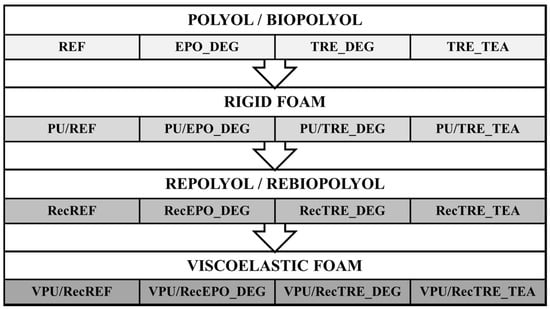
Figure 1.
The conceptual scheme of the research.
2.2. Repolyol and Rebiopolyols
Chemolysis of 4 different rigid polyurethane foams resulted in 4 different repolyols, which were analysed for their physico-chemical properties. One repolyol was obtained from a petrochemical foam, while three rebiopolyols were obtained from polyurethane biofoams made using 100% rapeseed oil polyols produced by various methods. The properties of the repolyols obtained are presented in this section. The entire amount of the recycled foam was successfully liquefied, and no solid residues were observed in the resulting rebiopolyols. The conditions of chemolysis process were optimized in our previous studies and have been described in earlier publications []. The process parameters were carefully selected to ensure complete liquefaction of the foams. Repolyols containing any fragments of unliquefied foam were considered unsuitable for further use, and the corresponding reaction conditions were recognized as inappropriate. Therefore, the yield of the chemolysis process can be regarded as 100%.
Hv of repolyols and rebiopolyols do not differ significantly from each other (Table 1) and are in the range of 445–485 mgKOH/g. Av of the repolyols RecREF, RecEPO_DEG and RecTRE_DEG also have similar values. The significantly higher Av of the RecTRE_TEA rebiopolyol compared to the other repolyols is due to the method used to obtain the biopolyol, which was then used in a glycosylated rigid polyurethane foam. This biopolyol was obtained by transesterification of rapeseed oil with triethanolamine. The use of triethanolamine as a modifying agent for the vegetable oil resulted in the introduction of additional amine groups into the polyurethane composition and ultimately also into the obtained rebiopolyol. Hence, the significantly higher Av of the rebiopolyol RecTRE_TEA. It is noteworthy that such a high amine number of the rebiopolyol RecTRE_TEA causes that the use of this rebiopolyol as a substrate in the preparation of a new polyurethane composition, affects the reactivity of the polyurethane system []. Therefore, the use of this rebiopolyol in some cases eliminates the need for an additional catalyst in foam formulations. Particularly at higher mass shares of RecTRE_TEA in the formulation, the autocatalytic character of the rebiopolyol used can be observed, which was confirmed in the analysis of the foaming process.

Table 1.
Selected properties of repolyol and rebiopolyols.
The density of all the repolyols obtained is similar and exceeds 1 g/cm3. The rebiopolyols have a significantly lower viscosity than the RecREF repolyols. This is due to the chemical structure (polymer chain length) and additional intermolecular interactions. The right viscosity is an important factor that influences the applicability of the raw material in professional applications. If the viscosity is too high, it can limit the possibilities of processing with dispensing robots.
Gel permeation chromatography analysis was performed for the repolyols obtained and for the polyols. The chromatograms are shown in Figure 2. In the presented chromatograms, it was observed that, for all the repolyols, there is a large peak at 21′, which is responsible for the presence of unreacted diethylene glycol in the reaction mixtures after the glycolysis processes. In addition, it was observed that the shape of the chromatograms of the repolyols overlaps in some places with the shape of the chromatograms of the starting polyols used in the foams synthesis. Additionally, a small peak is visible around the 20′ only in the chromatogram of the rebiopolyol RecTRE_TEA. This peak originates from free TEA, which in this case was formed through re-transesterification with DEG present in excess in the system. Although DEG primarily acts as a liquefying agent, under these conditions it can also participate in transesterification reactions involving degradation fragments of the polyurethane chains.
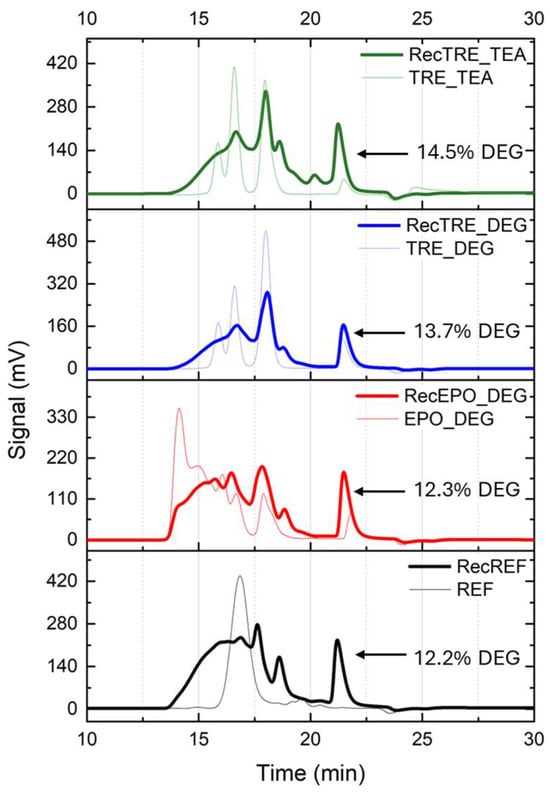
Figure 2.
Chromatograms of polyols and repolyols.
GPC analysis allowed the determination of the number (Mn) and the weight (Mw) average molar masses as well as molar mass dispersity (D) of the repolyols (Table 2). The highest molar masses are characterised by the repolyol RecREF (467 g/mol) and the lowest by RecTRE_TEA (394 g/mol). The difference in the average molar masses of the repolyols is due to the chemical structure of the polyols used in the preparation of rigid polyurethane foams subjected to glycolysis. The dispersity of the molar masses of all the repolyols is in the range of about 1.5 to about 2.0. The rebiopolyols, despite the presence of a bifunctional DEG residue, have a functionality above 3, and the repolyol above 4. This means that the use of the obtained repolyols in the synthesis of new foam materials will result in their additional crosslinking.

Table 2.
Selected properties of repolyol and rebiopolyols obtained from GPC analysis.
Due to the properties of the repolyols obtained, i.e., a high hydroxyl number and a functionality above 3, the product is ideally suited to the production of rigid polyurethane foams, such as panels, refrigerator insulation and sprayed roof insulation. Another potential application is the production of adhesives and coatings. Classic flexible foams usually contain polyols with a high molecular weight and long chains for flexibility, as well as a hydroxyl number below 100 mg KOH/g. However, viscoelastic foams are an exception, as they are synthesised using polyols with a low hydroxyl value and more branched polyols with a higher hydroxyl value. Therefore, it is reasonable to explore using rebiopolys as a substitute for high-hydroxyl-number petrochemical polyols in the synthesis of viscoelastic foams.
FTIR analysis of the repolyols confirmed the presence of hydroxyl groups (Figure 3). FTIR spectra of the polyurethane foams (PU/REF, PU/EPO_DEG, PU/TRE_DEG, PU/TRE_TEA) and their corresponding repolyols (RecREF, RecEPO_DEG, RecTRE_DEG, RecTRE_TEA) exhibit a similar set of characteristic absorption bands typical for polyurethane-based materials (Table 3). In all cases, bands assigned to stretching vibrations of O–H (3200–3600 cm−1), C–H (2850–2950 cm−1), and C=O (1700–1750 cm−1) are clearly visible, together with signals related to C–O and C–O–C vibrations in the 1250–1050 cm−1 region []. The presence of hydroxyl groups in rebiopolyols/repolyols is very important because it allows them to be used as a substitute for conventional petrochemical polyols in polyurethane foam formulations. By reacting with the isocyanate groups, the hydroxyl groups allow the urethane bond characteristic of polyurethanes to be obtained. The small peak visible in polyurethane foams in the range of 3400–3200 cm−1 corresponds primarily to N–H stretching vibrations of urethane and urea groups. This assignment is supported by the simultaneous presence of a deformation band near 1500–1600 cm−1, typical for N–H bending.
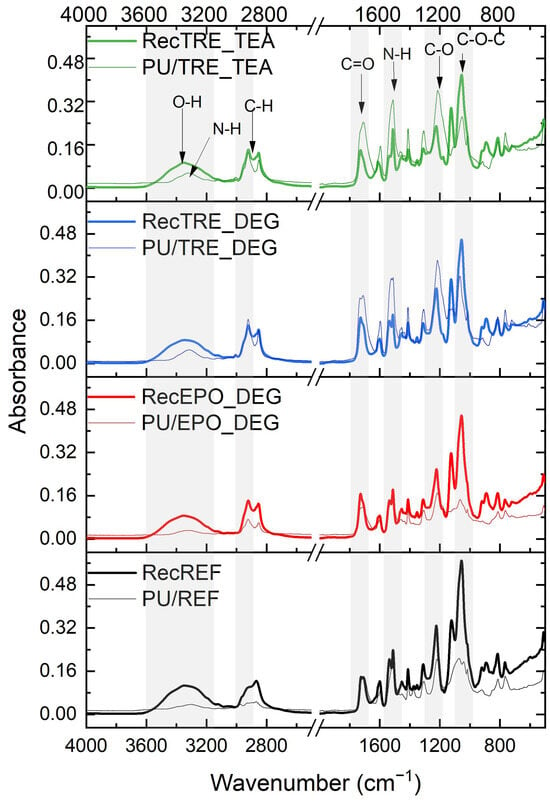
Figure 3.
FTIR spectra of repolyols and polyols.

Table 3.
Characterisation of selected FTIR bands.
2.3. Analysis of the Foaming Process of Viscoelastic Polyurethane Foam
A foaming process analysis was conducted on the prepared polyurethane systems to evaluate the reactivity of the selected systems. As it was mentioned above, the systems modified with RecTRE_DEG rebiopolyol required an increase in isocyanate due to foam collapse. This necessity is primarily attributed to the low functionality of the TRE_DEG biopolyol. The foam produced using this polyol, and subsequently subjected to chemical recycling, likely contained relatively short and weakly crosslinked polymer chains. Consequently, the rebiopolyol obtained from such foam also exhibited reduced functionality, leading to the formation of new polyurethane structures with insufficient crosslinking density. These shorter and less crosslinked chains were unable to provide adequate structural integrity, ultimately resulting in foam collapse. In this case, the isocyanate index (INCO) was increased to 0.60, which enhanced the degree of chain conversion and raised the crosslinking density, thereby strengthening the foam structure and preventing foam collapse. Moreover, a higher isocyanate content accelerated gelation and viscosity growth. The excess isocyanate also improved interactions with hydroxyl groups, caused a more efficient reaction with water, and facilitated chain extension through urea linkages, further reinforcing the polymer network. Consequently, increasing the isocyanate index enabled optimization of the balance between the gelation and foaming processes.
In contrast, the formulations modified with the RecTRE_TEA rebiopolyol required a lower amount of added due to their inherently high reactivity. The systems were so reactive that it was difficult to adequately mix the components and transfer the resulting mixtures into the mold. This behavior can be explained by the presence of TEA in RecTRE_TEA, what was confirmed by GPC analysis. TEA is a tertiary ethanolamine that is commonly used in polyurethane technology both as a tertiary amine catalyst and, because of its hydroxyl functionality, as a reactive component that can be incorporated into the polymer network. As a tertiary amine, TEA accelerates urethane-forming reactions (and the isocyanate–water reaction that generates CO2 in foaming process), thereby increasing the overall reaction rate and gelling activity of the polyurethane system. The catalytic effect of TEA-containing bio-polyols has been reported to enhance system reactivity and to reduce the amount of additional catalyst required []. The analysis of the foaming process allowed for the identification of characteristic foaming times, as well as the determination of the maximum temperature in the core of created foams, the maximum growth rate of reaction mixtures, and the shrinkage of the final foams (Figure 4).
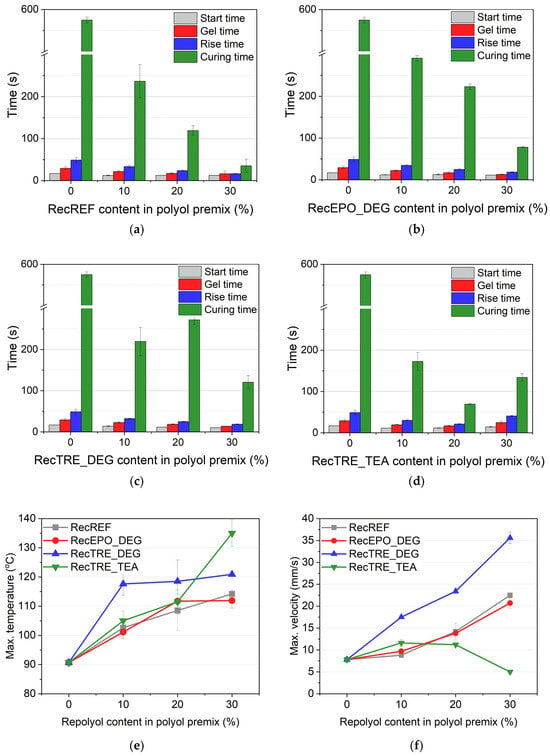
Figure 4.
Characteristics of the foaming process of polyurethane modified by (a) RecREF; (b) RecEPO_DEG; (c) RecTRE_DEG; (d) RecTRE_TEA and (e) max core temperature; (f) max rise velocity.
It was observed that, regardless of the repolyol type used, all times specific to the modified foam were shorter than those for the reference foam. Furthermore, it was observed that the greater the amount of repolyol used, the shorter the times were. However, this trend was not observed in the case of the foam modified with RecTRE_TEA, where the times initially decreased but then increased again. This phenomenon can be explained by the change in the catalytic system used in this case. For the reference foam obtained using only petrochemical polyols, the start time was 17 s, the gel time 39 s and the growth time 49 s. After the introduction of repolyols into the system, it was observed that the start time decreased to about 12 s and the growth time even shortened to 16 s.
In addition, it was observed that with the increase in the content of repolyols in the polyol masterbatch, the foam growth rate and the maximum temperature inside the material increase. These observations indicate the autocatalytic effect of repolyols on the course of the foaming process and the formation of polyurethane. Again, the exception is the system with the RecTRE_TEA rebiopolyol, in which the amount of catalyst was reduced. The graphs presented in Figure 5 show how the temperature in the foam core and the value of dielectric polarization change over time depending on the amount of rebiopolyol used. The value of dielectric polarization illustrates the rate of reactions taking place. When the value of dielectric polarization reaches a value close to zero, it means that there are no unreacted functional groups left in the reaction mixture []. The rapid approach to a value close to zero indicates that the reactions of forming polyurethane bonds and foaming reactions take place quickly. The presented graphs confirm the catalytic effect of repolyol, because both the temperature inside the foam is higher and the dielectric polarization value approaches zero faster in systems with a larger amount of repolyol. Kurańska obtained similar results when obtaining rigid polyurethane foams in which repolyol and rebiopolyols were used []. In addition to the amine groups present in the repolyol resulting from the degradation of bonds present in the polyurethane, there is also a large share of DEG, which can affect the course of the foaming process. DEG present in the post-recycling mixture is an unreacted liquefying agent. It is a short-chain diol that shows high reactivity with isocyanate, also accelerating the entire process of polyurethane formation.
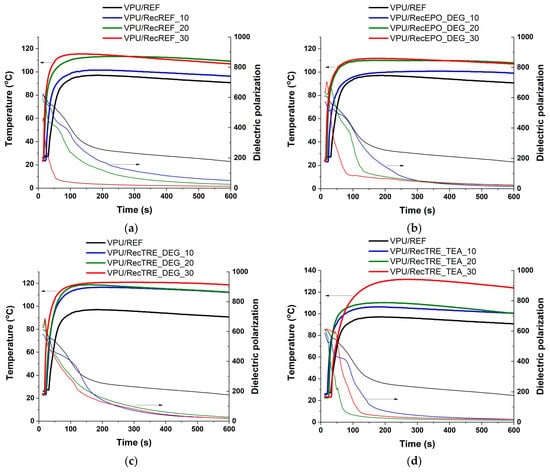
Figure 5.
Changes of temperature (left axis, thick line) and dielectric polarization (right axis, thin line) of reaction mixtures depending on the type and amount of repolyol used: (a) RecREF; (b) RecEPO_DEG; (c) RecTRE_DEG; (d) RecTRE_TEA.
2.4. Foam Structure Analysis
The cellular structure of the foam materials obtained was analysed, as this is responsible for many of the materials’ properties. This structure is influenced by various factors, including the foaming process, the apparent density of the materials obtained, and the type of raw materials used. The SEM photographs (Figure 6) show that the foam materials obtained had different structures, cell sizes and shapes.
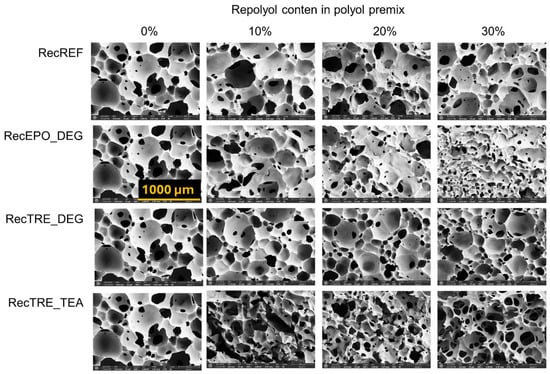
Figure 6.
SEM microphotograph of foam cell structure.
To evaluate the quality of the cell structure quantitatively, the ImageJ programme (version 1.53f) was used to analyse the foams cell structure. The average cell area, expressed in mm2, and cell density (number of cells per 1 mm3) were determined. The results of this analysis are shown in Figure 7.
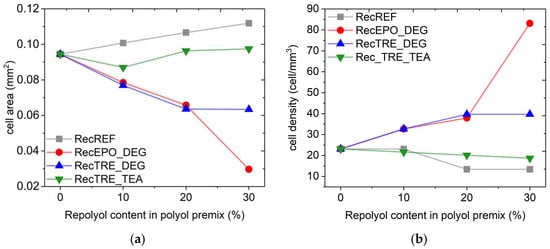
Figure 7.
Cell area (a) and cell density (b) of foams.
It was observed that adding a rebiopolyol derived from a petrochemical reference foam and a rebiopolyol derived from a foam obtained using the biopolyol TRE_TEA resulted in a slight increase in the surface area and a slight change in the density of the analysed cells. Using rebiopolyols derived from the chemolysis of foams obtained with the biopolyols EPO_DEG and TRE_DEG decreases the cell surface area and increases the cell density of the foam. This phenomenon may be due to these rebiopolys acting as surfactants. The addition of biopolyols to polyurethane foam systems often has a surfactant effect, reducing cell surface area [,].
2.5. Viscoelastic Polyurethane Foams Properties
Based on the same recipes as in the case of the analysis of the foaming process, samples of viscoelastic foams were obtained in larger forms, which could then be subjected to analysis of their physicomechanical properties.
The obtained foam samples were subjected to FTIR (Figure 8). The stretching vibrations of the N–H bonds are observed around 3345 cm−1. A weak band near 3500 cm−1 corresponds to the –OH groups originating from unreacted hydroxyl groups in polyols. The presence of this band is expected because the applied isocyanate index was below 1, indicating an excess of hydroxyl groups in the system. However, the low intensity of this peak confirms that most of these groups reacted with isocyanate to form urethane linkages.
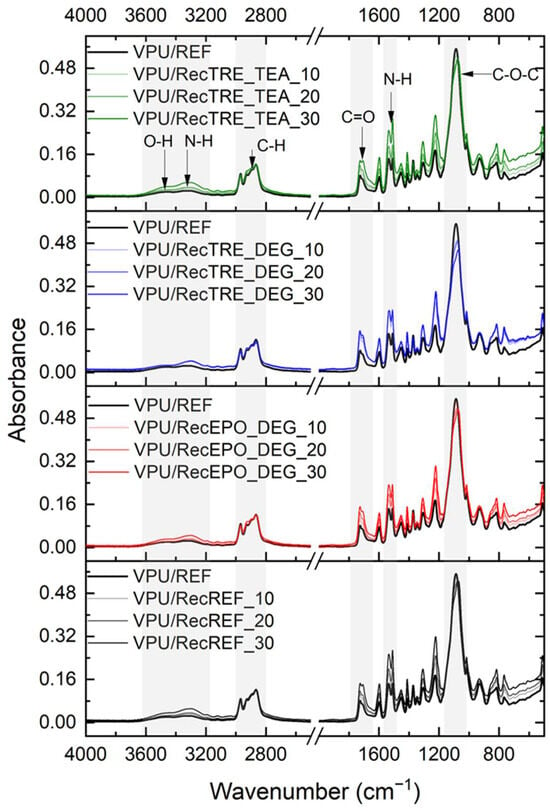
Figure 8.
FTIR spectrum of foams obtained with different mass fractions of repolyols.
The distinct peaks at approximately 2867 cm−1 and 2970 cm−1 are attributed to stretching vibrations of –CH2 groups in the soft segments derived from polyols. The absence of the –NCO band in the region of 2270–2240 cm−1 indicates complete consumption of the isocyanate groups during the foaming process.
Characteristic vibrations of the C=O bond in urethane groups are observed near 1708 cm−1, while the peaks at 1597 cm−1 correspond to aromatic C=C stretching vibrations. The bands around 1538 cm−1 and 1511 cm−1 are associated with bending and stretching vibrations of N–H groups. Additionally, C–O–C stretching from aliphatic ethers is evident at approximately 1095 cm−1 [,].
An increase in the intensity and integrated area of the broad O–H/N–H absorption band (3200–3600 cm−1) was observed with increasing repolyol content. A similar increase in the C–O–C stretching region (1100–1000 cm−1) suggests the appearance of a higher number of ether linkages and polyether fragments derived from the rebiopolyols.
Overall, the observed spectral changes confirm the chemical incorporation of rebiopolyols into the polyurethane structure affects microphase morphology of the obtained foams.
The foam samples to test their apparent density and mechanical properties were prepared according to proper standards. In the case of elastic and viscoelastic materials, the so-called hysteresis loops are determined. In order to plot the hysteresis loop, the compressive strength is measured during loading and unloading of the material. Thanks to the determination of the hysteresis loop, a number of properties characterizing elastic materials can be evaluated, including the ability to absorb energy, hardness and comfort factor.
The obtained reference foam materials were characterized by an apparent density of about 70 kg/m3. The polyurethane composition was selected in such a way as to obtain an apparent density that is often used in the industrial production of viscoelastic foams []. The analysis of the apparent density of modified foams showed that with the increase in the mass fraction of repolyols in the polyol premix, the apparent density of viscoelastic foams increases even to a value above 100 kg/m3 (Figure 9). A deviation from the described relationship is characterized by VPU/RecTRE_DEG foams, whose apparent density is practically unchanged, regardless of the mass fraction of rebiopolyol and is approx. 70 kg/m3. Moreover, all obtained viscoelastic foams, except VPU/TRE_DEG foams, are characterized by an apparent density higher than the unmodified foam. The highest apparent density in the group of VPU/RecTRE_TEA foams is characterized by VPU/RecTRE_TEA_20 foam. The change in apparent density usually affects the value of the material hardness. The higher the apparent density of the foam, the higher its hardness. The hardness of the reference foam was ca. 2 kPa. In the case of foams modified with RecREF, RecEPO_DEG and Rec TRE_TEA, it was observed that with increasing apparent density, the hardness of the foams also increases. The hardness of viscoelastic polyurethane foams modified with repolyols is definitely the highest in the case of foams with the highest, 30 wt.% share of repolyols. Foams with 10 wt.% content of repolyols are characterized by a similar hardness (2–3 kPa), as in the case of the unmodified reference foam.
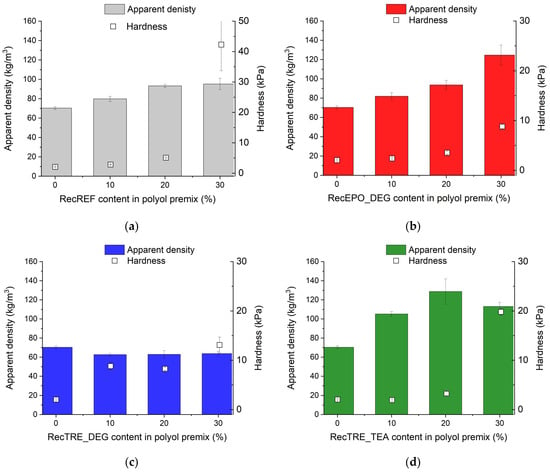
Figure 9.
Apparent density and hardness of viscoelastic polyurethane foams containing repolyols (a) RecREF; (b) RecEPO_DEG; (c) RecTRE_DEG; (d) RecTRE_TEA.
However, VPU/RecTRE_DEG_10 was an exception, with a significantly higher hardness of about 8 kPa, resulting from the higher isocyanate index (INCO = 0.60) applied to prevent foam collapse and to enhance foam structural integrity.
The hardness values of the viscoelastic polyurethane foams approximately coincide with the course of the hysteresis loop of the foams presented in Figure 6. It can be seen, for example, that the foams with the highest hardness required the highest force for their 75% deformation. For most of the foams tested, the hysteresis loop and properties such as hardness, comfort factor and hysteresis are calculated in accordance with the standard and determined at the fourth compression of the material. For materials containing 30% repolyol, i.e., VPU/RecREF_30, VPU/RecEPO_DEG_30, VPU/RecTRE_DEG_30 and VPU/RecTRE_TEA_30 the hysteresis loops were determined during the first compression, as the material was permanently deformed, thereby increasing the apparent density of the foam. Increasing the apparent density of the foam increases the compressive strength, so the results from the fourth deformation would not be representative.
The hysteresis loops of all polyurethane foams containing repolyols have a course characteristic for viscoelastic materials (Figure 10) []. The force required for 75% deformation of viscoelastic polyurethane foams modified with repolyols is in all cases higher comparing to the reference foam. Also, for all polyurethane foams with repolyols, the force required for 75% deformation of the foam material increases with the increasing mass fraction of repolyols in the polyol premix. VPU/RecTRE_TEA foams are characterized by the greatest susceptibility to deformation among the tested samples. Unfortunately, in the case of these materials, it was found that they undergo permanent deformation and, after applying force, they do not return to their initial shape.
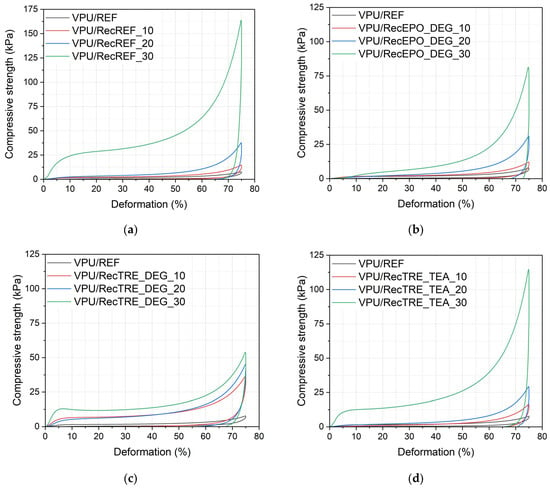
Figure 10.
Hysteresis loops of polyurethane foams with repolyols (a) RecREF; (b) RecEPO_DEG; (c) RecTRE_DEG; (d) RecTRE_TEA.
The addition of repolyol changes the structure of the foam material. Viscoelastic foams are characterized by a structure in which there are alternating rigid and flexible segments [], which provide unique material properties. The addition of repolyol to a properly composed mixture of polyols can affect the disruption of this structure. The high value of the hydroxyl number and the functionality of the obtained repolyols influences additional cross-linking of the resulting polyurethane, thereby increasing the hardness and stiffness of the foam, which may result in obtaining foams that are subject to permanent deformation because their cell structure is too rigid.
Support factor is a parameter that gives an information how comfortable the resulting foam will be to use. It is assumed that the most desirable foams for use in furniture are those that have a comfort factor of about 3 []. The comfort factor of viscoelastic polyurethane foams obtained with the participation of repolyols increases with the increase in the mass fraction of repolyols in the foams (Figure 11). A deviation from this relationship is characteristic of the VPU/RecTRE_TEA_20 foam, which is characterized by the highest comfort factor among the VPU/RecTRE_TEA foams. All modified viscoelastic polyurethane foams are characterized by a higher comfort factor and hysteresis than the unmodified reference foam, for which these values were 2.4% and 67%, respectively. Increasing the mass fraction of repolyol in viscoelastic foams also increases their ability to absorb energy (hysteresis) and elastic rebound (resilience). The resilience value most similar to the reference foam is found for VPU/RecEPO_DEG_10, VPU/RecTRE_TEA_10 and VPU/RecTRE_TEA_20. It should be noted, however, that all obtained foams have a resilience below 20%, which, despite the increase in this parameter, still indicates the ability to absorb energy.
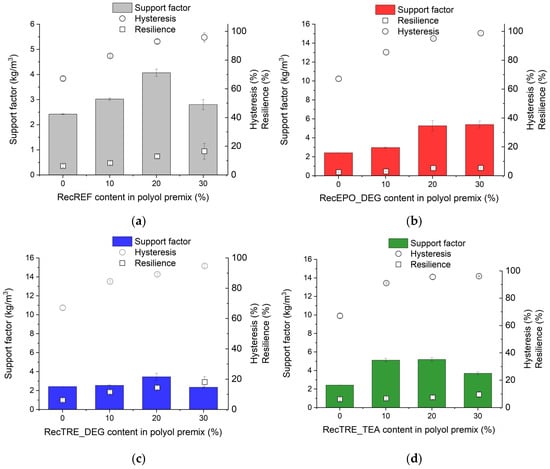
Figure 11.
Support factor, hysteresis and resilience of viscoelastic polyurethane foams containing repolyols (a) RecREF; (b) RecEPO_DEG; (c) RecTRE_DEG; (d) RecTRE_TEA.
The last test to which the obtained foams were subjected was the recovery time test. All viscoelastic polyurethane foams modified with repolyols have recovery times longer than in the case of the unmodified reference foam (Table 4). The recovery time of modified foams increases with the increase in the repolyol mass fraction in the foams. All viscoelastic foams with a repolyol content of 30 wt.% in the polyol premix are characterized by a recovery time longer than 300 s and underwent permanent deformation. Very long recovery time and permanent deformation disqualify this type of foam in the applications such as furniture, mattresses. The properties of the foams presented are confirmed by the calculated contents of hard and soft segments. As the amount of repolyol added to the polyol premix increases, the content of hard segments in the resulting polyurethanes also increases. Increased hard segment content results in increased material hardness and recovery times and even results in lower resistance to permanent deformation.

Table 4.
Recovery times and content of hard/soft segment of viscoelastic polyurethane foams containing rebiopolyols.
3. Materials and Methods
3.1. Raw Materials, Preparation and Test Methods for Repolyols
Four types of polyurethane foams were chemically recycled. A reference foam (PU/REF) obtained only from petrochemical raw materials and 3 biofoams. 3 various biopolyols, which replaced the petrochemical polyol by 100 wt.% were used to make the biofoams. The exact method of obtaining biopolyols, recycling foams and the obtained rebiopolyols is described in the work of Kuranska et al. []. In the present work, only basic information on obtaining recyclates is presented.
Reference rigid polyurethane foam (PU/REF) and rigid polyurethane biofoams modified with 100 wt.% biopolyols (PU/EPO_DEG; PU/TRE_DEG; PU/TRE_TEA) were subjected to a chemical recycling process—glycolysis. As a liquefying agent, pure DEG (Chempur, Piekary Śląskie, Poland) was used in a mass ratio of 1:1.5 relative to the dissolved mass of polyurethane foam. KOH (Avantor Performance Materials Poland S.A., Gliwice, Poland) was applied as the catalyst in an amount of 1 wt.% relative to the mass of DEG used. The glycolysis reaction yielded a repolyol (RecREF) and 3 rebiopolyols (RecEPO_DEG; RecTRE_DEG; RecTRE_TEA), which were then used as one of the substrates in the synthesis of viscoelastic polyurethane foams.
Repolyols and rebiopolyols obtained by glycolysis of rigid polyurethane foams were subjected to the following tests: hydroxyl value (Hv), amine value (Av), density, viscosity, determination of molar mass by gel permeation chromatography (GPC), and the presence of characteristic chemical groups by infrared spectroscopy (FTIR). Hv was tested according to PN-93/C-89052/03. Av was tested according to BN-69/6110-29. The density of repolyols was determined using the pycnometric method according to ISO 2811-1 []. Viscosity was tested using an EVA PLUS rotational rheometer from Lamy Rheology Instruments (Champagne au Mont d’Or, Lyon, France). GPC analysis was performed using a Knauer AZURA gel chromatograph from KNAUER Wissenschaftliche Geräte GmbH (Berlin, Germany). FTIR analysis of repolyols was performed using a Nicolet iS5 spectrometer from Thermo Scientific (Waltham, MA, USA). The functionality (f) of the repolyols was determined according to Equation (1).
3.2. Raw Materials and Preparation of Viscoelastic Polyurethane Foams
Viscoelastic polyurethane foams (VPU) with repolyol and rebiopolyols were obtained also using 3 different petrochemical polyols. Dibutyltin diacetate (Evonik Industries AG, Essen, Germany) was used as a catalyst, siloxane polyalkyleneoxide copolymer as surfactant (Momentive Performance Materials, Niskayuna, NY, USA) and polymeric methylene diphenyldiisocyanate containing 26.4% isocyanate groups. Selected properties of the petrochemical polyols used are shown in Table 5.

Table 5.
Selected properties of the raw materials.
Viscoelastic polyurethane reference foams and modified with rigid foam repolyols were prepared using a one-step method. In this method, non-reacting substrates were first mixed. An isocyanate was introduced into the polyol premix obtained in this way. After the components of the polyurethane composition were mixed again, it was poured into a polypropylene mould, in which free growth of the foam material took place. After growth, the foam was seasoned in an oven at 70 °C for one hour and then at room temperature for 24 h. Each foam material was repeated 3 times.
A viscoelastic polyurethane foam unmodified with repolyols (VPU/REF) and modified with repolyols of the rigid reference foam (VPU/RecREF), as well as with rebiopolyols of the rigid biofoams (VPU/RecEPO_DEG, VPU/RecTRE_DEG and VPU/RecTRE_TEA) were obtained. In the modified foams, conventional petrochemical polyols were replaced with repolyol or one of the rebiopolyols at 10 wt.%, 20 wt.% and 30 wt.%. The formulations of the individual foams are given in Table 6. The value of the isocyanate index (INCO) is also provided in this table. For most formulations, the index had the same value. INCO was modified only for the foams containing the Rec/TRE_DEG rebiopolyol. INCO is defined as the molar ratio of isocyanate (–NCO) groups used and necessary to the reactions with water and hydroxyl (–OH) groups.

Table 6.
Formulations of viscoelastic polyurethane foams modified with repolyols.
3.3. Analysis of the Foaming Process and Study of the Physicomechanical Properties of Viscoelastic Polyurethane Foams
An analysis of the effect of modifying the formulation used to produce viscoelastic polyurethane foam with different types and quantities of the repolyols was carried out using a FOAMAT device from Format-Masstechnic GmbH (Karlsruhe, Germany). The foaming process of the polyurethane composition was investigated by determining the start, rise, gelation and curing times. Temperature, pressure and dielectric polarisation of the foamed composition were also determined.
The morphology of the foam was examined using a scanning electron microscope (SEM) (Apreo 2 S LoVac, Thermo Fisher Scientific, Waltham, MA, USA). This was configured with a secondary electron detector in low vacuum mode and an accelerating voltage of 22 kV. Magnification of 200 times was used. The foam morphology was analysed (number of cells and cell cross-sectional area) using ImageJ software (version 1.53f, U. S. National Institutes of Health, Bethesda, MD, USA).
The content of soft and hard segments in viscoelastic foams was calculated as follows:
where, in Equation (2), mtotal is the total mass of substances reacting with each other in the reaction to obtain polyurethane, i.e., the sum of the masses of polyols (mpolyols), masses of repolyol (mrepolyol), masses of isocyanate (misocyanate); in Equation (3) mrec/SS is the amount of soft segments from the recycled material, mrec/DEG is the mass of DEG used in the chemical recycling reaction of the polyurethane foam, mrec/polyols is the mass of polyols in the foam subjected to chemical recycling, mrec is the total mass of the recyclate (DEG + PUR foam subjected to recycling); in Equation (4) SS means the percentage of soft segments in the viscoelastic polyurethane foam modified with repolyol; in Equation (5) HS means the percentage of rigid segments in the viscoelastic polyurethane foam modified with repolyol. The contribution of water and other additives, i.e., catalysts, to the total weight of the polyurethane has been deliberately omitted as they have a negligible effect on the SS value. It is important for the authors to show the trend of the change in the proportion of SS in the polyurethane on the properties of the foams.
Viscoelastic polyurethane foams were subjected to the following tests: apparent density, hardness, hysteresis, resilience and return time. The apparent density was determined in accordance with ISO 845 [] by determining the volume of the foam using a calliper and then weighing the foam on a technical balance. Tests for hardness (EN ISO 3386-1) [] and return time (IKEA® (Delft, The Netherlands) specification IOS-MAT-0076 []), as well as the comfort factor (ISO 3386-1 []), were determined using the Zwick/Roell, model Z005 from the Zwick Roell Group (Ulm, Germany). Resilience was determined according to ISO 8307:2000 []. The property tests were repeated for 3 samples of each foam material.
4. Conclusions
In the studies, raw material from chemically recycled polyurethane foams and biofoams was used to obtain viscoelastic foams. The obtained repolyols were used in the amounts from 10 to 30 wt.% in a mixture of polyols. It was found that the chemical structure of the polyols used to obtain the foams subjected to recycling affects the properties of the obtained repolyols. The type and chemical structure of the repolyol have a decisive influence on the morphology and performance of viscoelastic polyurethane foams. Repolyols derived from conventional polyurethane (RecREF) and from epoxidized plant oil (RecEPO_DEG) enabled the production of foams with properties comparable to those of commercial viscoelastic foams commonly used in furniture and bedding applications. The apparent density of these foams ranged from 70 to 90 kg/m3, and their hardness values were in the range of 2–4 kPa, which are typical for commercial memory foams providing optimal comfort and support balance. These materials also exhibited good resilience (below 20%) and a comfort factor close to 3, confirming their suitability for practical use.
In contrast, foams containing repolyols derived from transesterification-based systems (RecTRE_DEG and RecTRE_TEA) showed more pronounced structural deviations due to differences in hydroxyl functionality and reactivity. The RecTRE_DEG-modified foams, characterized by lower reactivity and reduced crosslinking density, required an increased isocyanate index to prevent collapse and achieve structural stability, resulting in a hardness around 8 kPa and a density close to 70 kg/m3. Conversely, RecTRE_TEA-based foams exhibited excessive crosslinking, leading to high hardness (up to 10–12 kPa) and increased density (above 100 kg/m3), accompanied by reduced elastic recovery and permanent deformation.
Overall, the incorporation of repolyols derived from both conventional and bio-based polyurethane waste can successfully replace up to 20 wt.% of virgin polyols without compromising the key mechanical and comfort parameters of viscoelastic foams. These findings demonstrate that properly selected repolyols, particularly RecREF and RecEPO_DEG, enable the development of sustainable polyurethane materials with performance equivalent to commercial viscoelastic foams, supporting the goals of circular economy and polymer recycling.
Author Contributions
Conceptualization, E.M., M.K. (Maria Kurańska), A.P.; methodology, E.M., M.K. (Michał Kucała), K.P., M.K. (Maria Kurańska), T.P.; validation, E.M., formal analysis, A.P.; investigation, E.M., M.K. (Michał Kucała), K.P., T.P.; data curation, M.K. (Michał Kucała), K.P., T.P.; writing—original draft preparation, E.M., M.K. (Michał Kucała); writing—review and editing, E.M., A.P.; supervision, A.P.; project administration, M.K. (Maria Kurańska). All authors have read and agreed to the published version of the manuscript.
Funding
This research was funded by the National Research Center in Poland (Narodowe Centrum Nauki, NCN) under contract number UMO-2021/43/D/ST5/01222.
Data Availability Statement
The data supporting the findings of this study are openly available in Mendeley Data at DOI: 10.17632/yzfj3yp3sr.1 (Version 1).
Acknowledgments
The authors are grateful Evonik Industries AG for supplying a catalyst and BorsodChem Zrt. company, and the members of the Wanhua Chemical Group, for supplying isocyanates.
Conflicts of Interest
The authors declare no conflicts of interest.
References
- Prociak, A.; Malewska, E.; Kurańska, M.; Bąk, S.; Budny, P. Flexible Polyurethane Foams Synthesized with Palm Oil-Based Bio-Polyols Obtained with the Use of Different Oxirane Ring Opener. Ind. Crops Prod. 2018, 115, 69–77. [Google Scholar] [CrossRef]
- Gama, N.; Godinho, B.; Madureira, P.; Marques, G.; Barros-Timmons, A.; Ferreira, A. Polyurethane Recycling Through Acidolysis: Current Status and Prospects for the Future. J. Polym. Environ. 2024, 32, 4777–4793. [Google Scholar] [CrossRef]
- Orabona, F.; Recupido, F.; Lama, C.; Polaczek, K.; Taddeo, F.; Salmi, T.; Serio, D. Cutting-edge development of non-isocyanate polyurethane (NIPU) foams: From sustainable precursors to environ-mental impact evaluation. Green Chem. 2025, 7, 7403–7444. [Google Scholar] [CrossRef]
- Kurańska, M.; Benes, H.; Kockova, O.; Kucała, M.; Malewska, E.; Schmidt, B.; Michałowski, S.; Zemła, M.; Prociak, A. Rebiopolyols—New Components for the Synthesis of Polyurethane Biofoams in Line with the Circular Economy Concept. Chem. Eng. J. 2024, 490, 151504. [Google Scholar] [CrossRef]
- Yang, W.; Dong, Q.; Liu, S.; Xie, H.; Liu, L.; Li, J. Recycling and Disposal Methods for Polyurethane Foam Wastes. Procedia Environ. Sci. 2012, 16, 167–175. [Google Scholar] [CrossRef]
- Gama, N.; Godinho, B.; Marques, G.; Silva, R.; Barros-Timmons, A.; Ferreira, A. Recycling of Polyurethane Scraps via Acidolysis. Chem. Eng. J. 2020, 395, 125102. [Google Scholar] [CrossRef]
- Salino, R.E.; Catai, R.E. A Study of Polyurethane Waste Composite (PUR) and Recycled Plasterboard Sheet Cores with Polyurethane Foam for Acoustic Absorption. Constr. Build. Mater. 2023, 387, 131201. [Google Scholar] [CrossRef]
- Hysek, S.; Neuberger, P.; Sikora, A.; Schonfelder, O.; Ditommaso, G. Waste Utilization: Insulation Panel from Recycled. Materials 2019, 12, 3075. [Google Scholar] [CrossRef]
- Kemona, A.; Piotrowska, M. Polyurethane Recycling and Disposal: Methods and Prospects. Polymers 2020, 12, 1752. [Google Scholar] [CrossRef] [PubMed]
- Guo, L.; Wang, W.; Guo, X.; Hao, K.; Liu, H.; Xu, Y.; Liu, G.; Guo, S.; Bai, L.; Ren, D.; et al. Recycling of Flexible Polyurethane Foams by Regrinding Scraps into Powder to Replace Polyol for Re-Foaming. Materials 2022, 15, 6047. [Google Scholar] [CrossRef] [PubMed]
- Roobankumar, R.; SenthilPandian, M. A Review of Utilization of Waste Polyurethane Foam as Lightweight Aggregate in Concrete. Heliyon 2024, 10, e40479. [Google Scholar] [CrossRef] [PubMed]
- Liu, W.; Zhang, Y.; Chen, P.; Shao, L.; Cao, Y.; Zhao, B.; Lee, E.C.; Wang, X.; Zhang, J. Scalable Manufacturing and Reprocessing of Vitrimerized Flexible Polyurethane Foam (PUF) Based on Commercial Soy Polyols. Ind. Chem. Mater. 2025, 3, 231–245. [Google Scholar] [CrossRef]
- Li, J.; Zhu, H.; Fang, D.; Huang, X.; Zhang, C.; Luo, Y. Mechanochemistry Recycling of Polyurethane Foam Using Urethane Exchange Reaction. J. Environ. Chem. Eng. 2023, 11, 110269. [Google Scholar] [CrossRef]
- Tao, Y.; Liang, X.; Zhang, J.; Lei, I.M.; Liu, J. Polyurethane Vitrimers: Chemistry, Properties and Applications. J. Polym. Sci. 2023, 61, 2233–2253. [Google Scholar] [CrossRef]
- Unal, K.; Maes, D.; Stricker, L.; Lorenz, K.; Du Prez, F.E.; Imbernon, L.; Winne, J.M. Foam-to-Elastomer Recycling of Polyurethane Materials through Incorporation of Dynamic Covalent TAD-Indole Linkages. ACS Appl. Polym. Mater. 2024, 6, 2604–2615. [Google Scholar] [CrossRef]
- Bandegi, A.; Montemayor, M.; Manas-Zloczower, I. Vitrimerization of Rigid Thermoset Polyurethane Foams: A Mechanochemical Method to Recycle and Reprocess Thermosets. Polym. Adv. Technol. 2022, 33, 3750–3758. [Google Scholar] [CrossRef]
- Liu, B.; Westman, Z.; Richardson, K.; Lim, D.; Stottlemyer, A.L.; Farmer, T.; Gillis, P.; Vlcek, V.; Christopher, P.; Abu-Omar, M.M. Opportunities in Closed-Loop Molecular Recycling of End-of-Life Polyurethane. ACS Sustain. Chem. Eng. 2023, 11, 6114–6128. [Google Scholar] [CrossRef]
- Zia, K.M.; Bhatti, H.N.; Ahmad Bhatti, I. Methods for Polyurethane and Polyurethane Composites, Recycling and Recovery: A Review. React. Funct. Polym. 2007, 67, 675–692. [Google Scholar] [CrossRef]
- Stančin, H.; Růžičková, J.; Mikulčić, H.; Raclavská, H.; Kucbel, M.; Wang, X.; Duić, N. Experimental Analysis of Waste Polyurethane from Household Appliances and Its Utilization Possibilities. J. Environ. Manag. 2019, 243, 105–115. [Google Scholar] [CrossRef]
- Guiraudon, V. European Court of Justice. EC Tax Rev. 2007, 16, 189–196. [Google Scholar] [CrossRef]
- Narine, S.S.; Kong, X.; Bouzidi, L.; Sporns, P. Physical Properties of Polyurethanes Produced from Polyols from Seed Oils: II. Foams. JAOCS J. Am. Oil Chem. Soc. 2007, 84, 65–72. [Google Scholar] [CrossRef]
- Vale, M.; Mateus, M.M.; Galhano dos Santos, R.; Nieto de Castro, C.; de Schrijver, A.; Bordado, J.C.; Marques, A.C. Replacement of Petroleum-Derived Diols by Sustainable Biopolyols in One Component Polyurethane Foams. J. Clean. Prod. 2019, 212, 1036–1043. [Google Scholar] [CrossRef]
- Olszewski, A.; Kosmela, P.; Piszczyk, Ł. Synthesis and Characterization of Biopolyols through Biomass Liquefaction of Wood Shavings and Their Application in the Preparation of Polyurethane Wood Composites. Eur. J. Wood Wood Prod. 2022, 80, 57–74. [Google Scholar] [CrossRef]
- Bresolin, D.; Bolzan, A.; Sayer, C.; de Araújo, P.H.H.; de Oliveira, D. Rigid Polyurethane Foam Obtained from Enzymatic Glycerolysis: Evaluation of the Influence of Lipase on Biopolyol Composition and Polymer Characteristics. J. Polym. Environ. 2021, 29, 3900–3908. [Google Scholar] [CrossRef]
- Li, H.; Wang, B.; Shui, H.; Wei, Q.; Xu, C.C. Preparation of Bio-Based Polyurethane Hydroponic Foams Using 100% Bio-Polyol Derived from Miscanthus through Organosolv Fractionation. Ind. Crops Prod. 2022, 181, 114774. [Google Scholar] [CrossRef]
- Aneta, B.-B.; Bórawski, P.; Holden, L.; Rokicki, T. Development of Oil Industry in Poland in the Context of the European Union. Foods 2024, 13, 3406. [Google Scholar] [CrossRef]
- EBB STATISTICAL REPORT 2023. Available online: www.ebb-eu.org (accessed on 1 September 2025).
- Recupido, F.; Lama, G.C.; Steffen, S.; Dreyer, C.; Seidlitz, H.; Russo, V.; Lavorgna, M.; De Luca Bossa, F.; Silvano, S.; Boggioni, L.; et al. Efficient Recycling Pathway of Bio-Based Composite Polyurethane Foams via Sustainable Diamine. Ecotoxicol. Environ. Saf. 2024, 269, 115758. [Google Scholar] [CrossRef]
- Zemła, M.; Kurańska, M.; Vevere, L.; Kirpluks, M.; Malewska, E.; Apostolou, M.S.; Prociak, A. Effect of Chemical Structure and Apparent Density of Rigid Polyurethane Foams on the Properties of Their Chemical Recycling Products. Materials 2024, 17, 6190. [Google Scholar] [CrossRef] [PubMed]
- Henriques, I.R.; Rouleau, L.; Castello, D.A.; Borges, L.A.; Deü, J.F. Viscoelastic Behavior of Polymeric Foams: Experiments and Modeling. Mech. Mater. 2020, 148, 103506. [Google Scholar] [CrossRef]
- Polyurethane Foam Association. Viscoelastic Memory Foam. In-Touch 2016, 11, 1–7. [Google Scholar]
- Grzęda, D.; Węgrzyk, G.; Leszczyńska, M.; Szczepkowski, L.; Gloc, M.; Ryszkowska, J. Viscoelastic Polyurethane Foams for Use as Auxiliary Materials in Orthopedics. Materials 2022, 15, 133. [Google Scholar] [CrossRef]
- Aou, K.; Ge, S.; Mowery, D.M.; Zeigler, R.C.; Gamboa, R.R. Two-Domain Morphology in Viscoelastic Polyurethane Foams. Polymer 2015, 56, 37–45. [Google Scholar] [CrossRef]
- Bedell, M.; Brown, M.; Kiziltas, A.; Mielewski, D.; Mukerjee, S.; Tabor, R. A Case for Closed-Loop Recycling of Post-Consumer PET for Automotive Foams. Waste Manag. 2018, 71, 97–108. [Google Scholar] [CrossRef]
- Mohammad, M.; Nikje, A.; Garmarudi, A.B. Regeneration of Polyol by Pentaerythritol-Assisted Glycolysis of Flexible Polyurethane Foam Wastes. Iran. Polym. J. 2010, 19, 287–295. [Google Scholar]
- Molero, C.; De Lucas, A.; Romero, F.; Rodríguez, J.F. Influence of the Use of Recycled Polyols Obtained by Glycolysis on the Preparation and Physical Properties of Flexible Polyurethane. J. Appl. Polym. Sci. 2008, 109, 617–626. [Google Scholar] [CrossRef]
- Simón, D.; Borreguero, A.M.; De Lucas, A.; Rodríguez, J.F. Glycolysis of Viscoelastic Flexible Polyurethane Foam Wastes. Polym. Degrad. Stab. 2015, 116, 23–35. [Google Scholar] [CrossRef]
- Kraitape, N.; Thongpin, C. Influence of Recycled Polyurethane Polyol on the Properties of Flexible Polyurethane Foams. Energy Procedia 2016, 89, 186–197. [Google Scholar] [CrossRef]
- Kiss, G.; Rusu, G.; Bandur, G.; Hulka, I.; Romecki, D.; Péter, F. Advances in Low-Density Flexible Polyurethane Foams by Optimized Incorporation of High Amount of Recycled Polyol. Polymer 2021, 13, 1736. [Google Scholar] [CrossRef]
- Aksu, Y.; Haykiri-Acma, H.; Yaman, S. Recycle of Flexible Polyurethane Foam by Acidolysis and Reuse of Recovered Polyol. J. Polym. Environ. 2024, 33, 1147–1158. [Google Scholar] [CrossRef]
- Kattiyaboot, T.; Thongpin, C. Effect of Natural Oil Based Polyols on the Properties of Flexible Polyurethane Foams Blown by Distilled Water. Energy Procedia 2016, 89, 177–185. [Google Scholar] [CrossRef]
- Vashisht, U.; Kaushal, J. Syntesis and Kinetic Studies of Rigid Polyurethane Foam Based on Modified Castor Oil. Chitkara Chem. Rev. 2016, 1, 71–82. [Google Scholar] [CrossRef]
- Prociak, A.; Szczepkowski, L.; Ryszkowska, J.; Kurańska, M.; Auguścik, M.; Malewska, E.; Gloc, M.; Michałowski, S. Influence of Chemical Structure of Petrochemical Polyol on Properties of Bio-Polyurethane Foams. J. Polym. Environ. 2019, 27, 2360–2368. [Google Scholar] [CrossRef]
- Belsare, N.; Nandi, S. Sustainable Polyurethane Foam Formulation with Bio-Polyol Blends for Automotive Seating Applications. Ind. Crops Prod. 2025, 226, 120672. [Google Scholar] [CrossRef]
- Uram, K.; Prociak, A.; Kurańska, M. Influence of the Chemical Structure of Rapeseed Oil-Based Polyols on Selected Properties of Polyurethane Foams. Polimery 2020, 65, 698–707. [Google Scholar] [CrossRef]
- Kirpluks, M.; Cabulis, U.; Kurańska, M.; Prociak, A. Three Different Approaches for Polyol Synthesis from Rapeseed Oil. Key Eng. Mater. 2013, 559, 69–74. [Google Scholar] [CrossRef]
- Auguścik-Królikowska, M.; Ryszkowska, J.; Szczepkowski, L.; Kwiatkowski, D.; Kołbuk-Konieczny, D.; Szymańska, J. Viscoelastic Polyurethane Foams with the Addition of Mint. Polimery 2020, 65, 196–207. [Google Scholar] [CrossRef]
- Diani, J.; Liu, Y.; Gall, K. Finite strain 3D thermoviscoelastic constitutive model for shape memory polymers. Polym. Eng. Sci. 2006, 46, 486–492. [Google Scholar] [CrossRef]
- White, S.W.; Kim, S.K.; Bajaj, A.K.; Davies, P.; Showers, D.K.; Liedtke, P.E. Experimental Techniques and Identification of Nonlinear and Viscoelastic Properties of Flexible Polyurethane Foam. Nonlinear Dyn. 2000, 22, 281–313. [Google Scholar] [CrossRef]
- Zou, J.; Chen, Y.; Liang, M.; Zou, H. Effect of Hard Segments on the Thermal and Mechanical Properties of Water Blown Semi-Rigid Polyurethane Foams. J. Polym. Res. 2015, 22, 120. [Google Scholar] [CrossRef]
- Auguścik-Królikowska, M.; Ryszkowska, J.; Kurańska, M.; Wantulok, M.; Gloc, M.; Szczepkowski, L.; Dąbkowska-Susfał, K.; Prociak, A. Composites of Open-Cell Viscoelastic Foams with Blackcurrant Pomace. Materials 2021, 14, 934. [Google Scholar] [CrossRef]
- ISO 2811-1; Paints and varnishes—Determination of density—Part 1: Pycnometer method. ISO: Geneva, Switzerland, 2023.
- ISO 845; Cellular plastics and rubbers—Determination of apparent density. ISO: Geneva, Switzerland, 2006.
- EN ISO 3386-1; Flexible cellular polymeric materials—Determination of stress–strain characteristics in compression—Part 1: Low-density materials. CEN: Brussels, Belgium; ISO: Geneva, Switzerland, 1997.
- IOS-MAT-0076; IKEA® specification. IKEA: Delft, The Netherlands, 2021.
- ISO 8307:2007; Flexible Cellular Polymeric Materials—Determination of Resilience by Ball Rebound. ISO: Geneva, Switzerland, 2007.
Disclaimer/Publisher’s Note: The statements, opinions and data contained in all publications are solely those of the individual author(s) and contributor(s) and not of MDPI and/or the editor(s). MDPI and/or the editor(s) disclaim responsibility for any injury to people or property resulting from any ideas, methods, instructions or products referred to in the content. |
© 2025 by the authors. Licensee MDPI, Basel, Switzerland. This article is an open access article distributed under the terms and conditions of the Creative Commons Attribution (CC BY) license (https://creativecommons.org/licenses/by/4.0/).